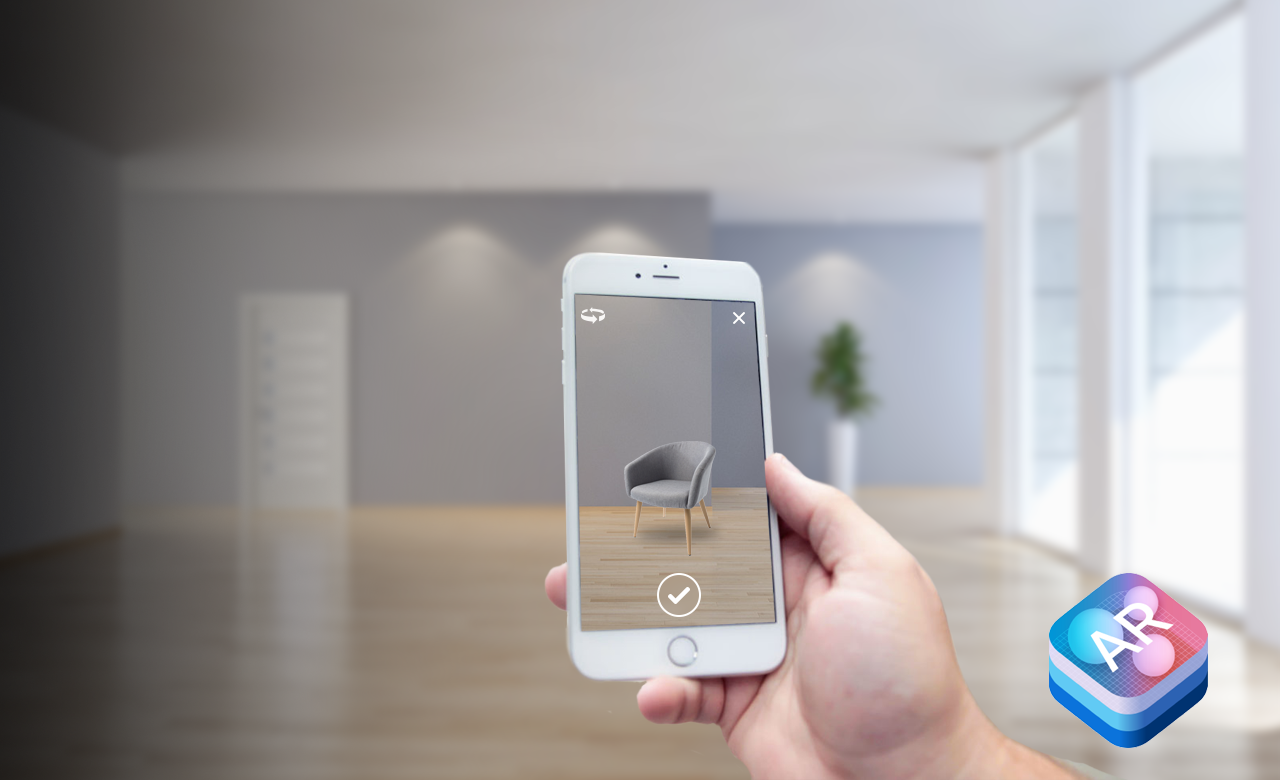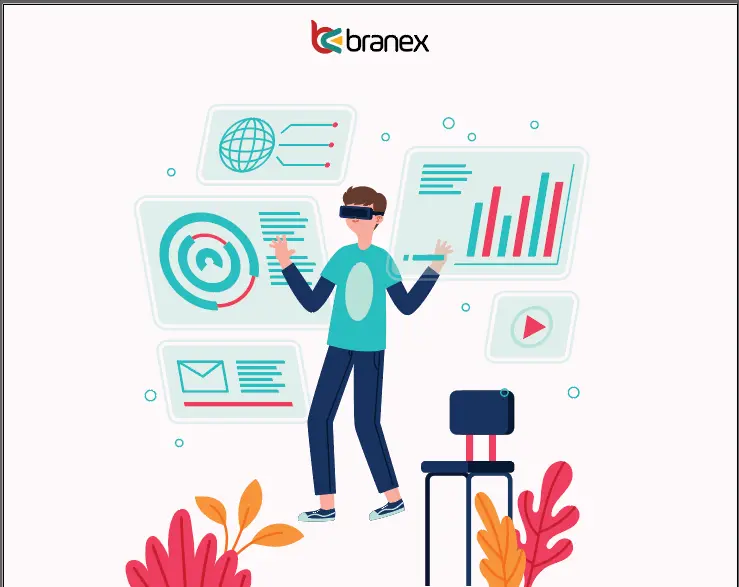Augmented Reality (AR) apps are transforming the way we experience the world around us, and with the massive growth of AR users in the USA (expected to reach over 1.7 billion by 2024), it’s no wonder businesses are jumping on board.
Imagine trying on that new shade of lipstick virtually before you buy it, or seeing how those sleek new couches would look right there in your living room – all from your phone!
But here’s the real question – how much does it ACTUALLY cost to create an augmented reality (AR) app?
Well, you don’t have to worry about future AR innovators.
In this article, we are going to break down the costs, complexities, and cool features that go into building your very own piece of AR magic, helping you estimate the best budget.
What is an AR App and Why Should You Care?

Forget everything you think you know about interactive experiences – Augmented Reality (AR) apps are here to revolutionize the way you do business.
Just think for a moment, a potential customer walks into your store, holds up their phone, and sees a 3D model of your latest product displayed right there on the shelf.
They can change the color, and size, or even see how it would look in their own home, all without ever leaving the store. That’s how powerful AR apps can become eventually. AR apps are software programs that use your phone’s camera to overlay digital content in the real world.
It creates an interactive experience that allows users to engage with your brand in a whole new way. Why do we believe it’s necessary to invest your budget in an AR app?
Here are just a few reasons why you should consider Augmented Reality (AR) apps for your business in the USA.
- Boost Sales and Conversions: AR apps let customers visualize products before they buy, leading to more informed purchasing decisions and increased sales.
- Enhance Customer Experience: AR apps create a fun and interactive way for customers to learn about your products, leading to greater brand loyalty.
- Stand Out from the Competition: Be an early adopter of AR technology and wow your customers with a cutting-edge shopping experience.
- Improve Training and Efficiency: Use AR apps to train employees on complex procedures or visualize maintenance tasks, leading to increased productivity and reduced costs.
AR apps are no longer a futuristic fantasy – they’re a powerful marketing and sales tool within your reach. So let’s dive in and explore the associated cost of building such AR apps.
What is the Average Cost of Developing an AR App?

So, how much does this AR app magic cost?
That’s a fantastic question, and the truth is it depends. Just like building a house, the final price tag depends on the size, features, and all the fancy features you want to include.
Here’s the general range to set your expectations – developing an AR app in the USA can cost anywhere from $10,000 to $200,000. Don’t worry! We will break down this range into sections.
For now, just remember the cooler the features, the more complex the app will be, and the better will be the price tags accordingly. So without further ado, let’s read all that we know.
The Cost of AR App Development Based on Complexity
The cost of an AR app will depend largely on its complexity. An AR app development project is pretty much similar to building stuff with Legos. A simple design takes less time to snap together than a complex spaceship.
Similarly, a basic AR app with a single overlay might take a few hours, while a feature-rich game with custom characters and interactions will require months of development. More complex apps mean more developer hours, which translates to higher costs.
Here’s a breakdown of Augmented Reality app development costs based on complexity levels:
| AR App Complexity | Estimated Cost Range (USD) | Features |
| Simple | $10,000 – $50,000 | * Single core function * Pre-built AR tools & templates |
| Intermediate | $50,000 – $200,000 | * Multiple features * Object recognition * 3D animations * User interaction |
| Complex | $250,000 – $800,000+ | * Groundbreaking features * Custom algorithms * Cutting-edge technology * Extensive development |
The Cost of AR App Development Based on Region
The cost of an AR app also differs based on which region you reside in. The average hourly rate for AR developers varies greatly across the globe. Regions with a high cost of living often have higher developer rates. For example, hiring an Augmented Reality developer in North America or Western Europe will likely cost more compared to someone in Southeast Asia or Eastern Europe.
Here’s a ballpark range of how much the price varies on the region for hiring AR developers:
- North America: $150 per hour and upwards
- Western Europe: $70 – $100 per hour
- Eastern Europe: $25 – $30 per hour
- Southeast Asia (including India): $15 – $30 per hour
As we can see, there’s a potential difference of $120 or more per hour between North America and Southeast Asia. Here’s a breakdown of the cost based on the region level:
| Region | Average Hourly Rate (USD) | Estimated Total Project Cost (USD) | Factors Affecting Cost |
| North America | $150+ | $100,000 – $500,000+ | High developer rates, complex projects common |
| Western Europe | $70 – $100 | $50,000 – $300,000 | High developer rates, a mix of project complexity |
| Eastern Europe | $25 – $50 | $25,000 – $150,000 | Lower developer rates, potential communication challenges |
| Southeast Asia (including India) | $15 – $30 | $15,000 – $100,000 | Lowest developer rates, project complexity may be limited |
| South America | $65 – $150 | $40,000 – $200,000 | Varied developer rates, project complexity mix |
| Australia & New Zealand | $60 – $100 | $40,000 – $250,000 | High living cost, skilled developer pool |
| Central Asia | $30 – $60 | $20,000 – $100,000 | Emerging AR development market, potential talent limitations |
The Cost of AR App Development Based on Category
Just as much as the location and the complexity of the app play a role in cost estimation, so does the fact of what you want to achieve with your augmented reality app solution.
To develop an augmented reality app, you will need to consider the goals you want to achieve with your application.
Here’s a breakdown of estimated costs for different Augmented Reality (AR) app categories:
| Category | Description | Estimated Cost Range (USD) | Key Cost Drivers |
| Simple AR Filters | Fun and basic filters for social media or entertainment (e.g., animal ears, silly hats) |
$5,000 – $20,000 | Limited development time, basic 3D models/textures |
| Product Visualization | Allows users to virtually place furniture, clothes, or other products in their environment |
$20,000 – $50,000 | Object scanning/modeling, integration with e-commerce platforms |
| Educational Apps | Interactive learning experiences with AR elements (e.g., exploring the solar system, or dissecting a frog) |
$30,000 – $100,000 | Educational content creation, potentially complex AR interactions |
| AR Games | Simple to moderately complex AR games with basic characters and environments |
$50,000 – $200,000 | Game design, character animation, potential multiplayer functionality |
| Complex AR Games | Highly immersive AR games with intricate characters, environments, and advanced features (e.g., location-based experiences) |
$200,000+ | Extensive development time, high-quality 3D assets, potentially using real-time data integration |
| AR Business/Industrial Apps | Apps for maintenance, training, or data visualization in professional settings |
$50,000 – $500,000+ | Specialized features, potential integration with existing enterprise systems |
Augmented Reality (AR) App Development Cost Formula
While there’s no single perfect formula to pinpoint the exact cost of your AR app.
Here’s a comprehensive breakdown to help you estimate the development cost:
Total Cost = (Development Time * Hourly Rate) + Additional Costs
Here’s a Breakdown of Each Variable:
- Development Time: This refers to the total number of hours required to develop your AR app. It encompasses various stages like:
- Planning & Design: User interface (UI) / User experience (UX) design, storyboarding, and feature planning.
- Development: Coding the app functionalities, integrating AR frameworks and SDKs, 3D modeling, and animation (if applicable).
- Testing & Refinement: Bug testing, performance optimization, ensuring AR functionality works seamlessly.
- Hourly Rate: This depends on the region and experience level of your development team. You can use the ranges provided in the previous section (AR Developer Hourly Rates and Project Costs by Region) as a reference.
- Additional Costs: These can include:
- Project Management: Costs associated with coordinating the development process, especially for outsourced projects.
- Content Creation: Development of high-quality 3D models, textures, animations, or any other visual elements.
- Backend Development: If your app requires server-side functionality or data storage, factor in backend development costs.
- API Integrations: Costs associated with integrating with third-party APIs for features like social media sharing or location services.
- Quality Assurance (QA) Testing: Thorough testing across various devices and scenarios for a smooth user experience.
- App Store Fees: Submission fees for publishing your app on the Apple App Store or Google Play Store.
Here’s an Example of How to Use the Formula:
Imagine you’re building a simple AR product visualization app in North America. You estimate the development time to be 300 hours, and based on the region, you target an average hourly rate of $175.
Development Cost = (300 hours * $175/hour) = $52,500
Additional Costs (estimated):
- Project Management: $5,000
- Content Creation (3D models): $10,000
Total Estimated Cost: $52,500 (Development Cost) + $5,000 (Project Management) + $10,000 (Content Creation) = $67,500.
Now, this is just a ballpark figure, and the actual app development cost can swing depending on how fancy your app gets. To get a more solid estimate, chat with some experienced AR app developers in the planning stage. They can eyeball your project and give you a better idea of how much time and people you’ll need. Always remember, stuff happens! Factor in some extra cash for unexpected bumps in the road or if you decide to add some cool new features along the way.
How Long Does it Take to Build an AR App?

The time required to build an AR app totally depends on two factors; how complex the AR app is and what is your team’s expertise. Each AR app differs from one another based on two factors, the complexity of the app and the required team expertise.
Here’s a price breakdown.
- Simple AR Apps (2-3 months): Imagine a basic filter app that adds silly hats or lets you virtually place furniture in your room. These can be built relatively quickly by a small team using pre-built tools and templates.
- Moderately Complex AR Apps (4-6 months): These apps have more features and functionality, like educational experiences with 3D object interaction or basic AR games. Development time increases as features become more intricate.
- Complex AR Apps (6 months+): These are highly immersive games with intricate characters, environments, and real-time data integration. Think location-based games or industrial training apps. Expect a longer development timeline due to the advanced features and potential custom app development required.
Factors Associated with How Long It Takes to Build an AR App

When it comes to how long it takes to create an AR app, here are a few important factors that need to be addressed. Since each app is unique, it requires its own specific time to cook up and add those extra special ingredients.
Let’s explore some of the relevant factors that affect the design time of your AR app development.
App’s Complexity
While complexity is definitely a key factor in AR app development timelines, let’s not get discouraged! There’s a whole spectrum of AR experiences you can create, and some can be built surprisingly fast. Imagine wanting a fun filter app that lets users virtually try on sunglasses or add fantastical creatures to their living room. These “light” experiences, with simpler features and pre-built elements, can be whipped up in as little as 4-6 weeks by a skilled team.
Technical Expertise & Skillset
The technical expertise and skillset of your chosen development team significantly influence the timeline for your AR app. Having a team with a proven track record in AR development possesses the knowledge and problem-solving skills to navigate complex technical challenges efficiently. They’ve likely encountered similar hurdles before, allowing them to implement solutions quickly and avoid delays. Experienced teams have established development processes optimized for AR projects. It includes familiarity with relevant tools, frameworks, and best practices, leading to a smoother and more efficient development workflow.
UI/UX Design and Assets
Think of your app’s design as the bridge between the real world and the AR experience. Crafting a user-friendly interface (UI) and intuitive user experience (UX) is of significance. But it also takes time. Developing high-quality 3D models, animations, and other visual assets all contribute to the overall development time. For instance, an app with a simple user interface & pre-made assets is relatively easier and quicker to build compared to an app with a custom UI/UX design, unique animations, and complex 3D models.
Features & Functionalities
The more features you pack into your AR app, the more time it takes to build. Simple features like basic object placement might be quick. However, complex features like real-time data processing, intricate interactions, or location-based experiences require significantly more development hours. Let’s say, if you’re aiming to have more complex features such as real-time data processing (such as real-time AR game live updates), intricate interactions with virtual objects in complex ways, or location-based experiences to interact with the user’s physical location, it requires more development hours to implement complex codes & important functionalities.
Testing and Quality Assurance (QA)
You wouldn’t want your users encountering glitches in the AR world, would you? Similarly, a simple app may require rather less time for quality assurance, compared to a more complex app project, especially one that’s bug-free and offers a smoother user experience. The more complex your testing needs become, the longer this stage can take so it somewhat depends on the app development team sequentially.
Key Takeaways:
- The cost of developing an AR app can vary depending on the complexity of the app, the region where the app is being developed, and the category of the app.
- Simple AR apps can cost anywhere from $10,000 to $50,000, while complex AR apps can cost upwards of $800,000.
- The time it takes to develop an AR app can also vary depending on the complexity of the app. Simple AR apps can be developed in a few months, while complex AR apps can take a year or more to develop.
Why Choose Branex for Your Next Augmented Reality App?
Branex is your one-stop brand solution for pioneering the next generation of user experiences with Augmented Reality App Development Services. We transform your vision into reality, by seamlessly blending the physical and digital worlds. Our team of AR specialists leverages cutting-edge technology to craft customized solutions that overlay rich digital information onto your real environment. Branex empowers you to unlock the true potential of AR, enhancing everything from training procedures to product visualization.
Choose Branex to bridge the physical and digital divide and bring your augmented reality vision to life.




